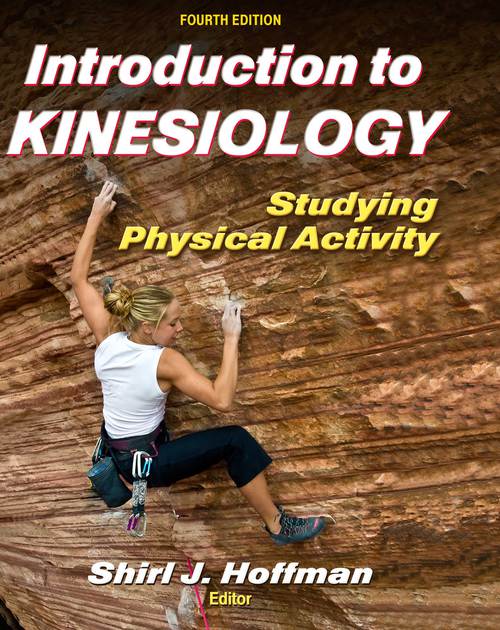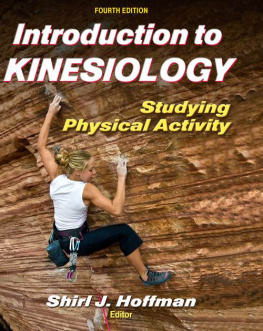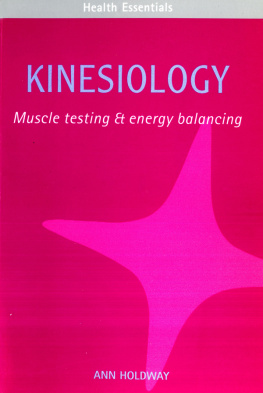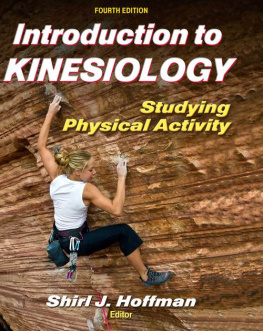Shirl J Hoffman - Introduction to kinesiology
Here you can read online Shirl J Hoffman - Introduction to kinesiology full text of the book (entire story) in english for free. Download pdf and epub, get meaning, cover and reviews about this ebook. City: Champaign, IL, year: 2013, publisher: Human Kinetics, genre: Religion. Description of the work, (preface) as well as reviews are available. Best literature library LitArk.com created for fans of good reading and offers a wide selection of genres:
Romance novel
Science fiction
Adventure
Detective
Science
History
Home and family
Prose
Art
Politics
Computer
Non-fiction
Religion
Business
Children
Humor
Choose a favorite category and find really read worthwhile books. Enjoy immersion in the world of imagination, feel the emotions of the characters or learn something new for yourself, make an fascinating discovery.
- Book:Introduction to kinesiology
- Author:
- Publisher:Human Kinetics
- Genre:
- Year:2013
- City:Champaign, IL
- Rating:4 / 5
- Favourites:Add to favourites
- Your mark:
- 80
- 1
- 2
- 3
- 4
- 5
Introduction to kinesiology: summary, description and annotation
We offer to read an annotation, description, summary or preface (depends on what the author of the book "Introduction to kinesiology" wrote himself). If you haven't found the necessary information about the book — write in the comments, we will try to find it.
Introduction to kinesiology — read online for free the complete book (whole text) full work
Below is the text of the book, divided by pages. System saving the place of the last page read, allows you to conveniently read the book "Introduction to kinesiology" online for free, without having to search again every time where you left off. Put a bookmark, and you can go to the page where you finished reading at any time.
Font size:
Interval:
Bookmark:

Fourth Edition
Shirl J. Hoffman, EdD
University of North Carolina at Greensboro
Editor

Human Kinetics
Library of Congress Cataloging-in-Publication Data
Introduction to kinesiology / Shirl J. Hoffman, editor. -- 4th ed.
p. ; cm.
Includes bibliographical references and index.
I. Hoffman, Shirl J., 1939
[DNLM: 1. Kinesiology, Applied. 2. Motor Activity. 3. Physical Education and Training. WE 103]
612.7'6--dc23
2012030828
ISBN-10: 1-4504-3432-0 (print)
ISBN-13: 978-1-4504-3432-4 (print)
Copyright 2013, 2009, 2005, 2000 by Human Kinetics, Inc.
All rights reserved. Except for use in a review, the reproduction or utilization of this work in any form or by any electronic, mechanical, or other means, now known or hereafter invented, including xerography, photocopying, and recording, and in any information storage and retrieval system, is forbidden without the written permission of the publisher.
Permission notices for photographs reprinted in this book can be found on pages xv-xvi.
The web addresses cited in this text were current as of September 2012, unless otherwise noted.
Acquisitions Editor: Myles Schrag
Developmental Editor: Amanda S. Ewing
Assistant Editors: Kali Cox and Casey A. Gentis
Copyeditor: Julie Anderson
Indexer: Andrea J. Hepner
Permissions Manager: Dalene Reeder
Graphic Designer: Nancy Rasmus
Graphic Artist: Denise Lowry
Cover Designer: Keith Blomberg
Photograph (cover): Greg Epperson/fotolia.com
Photo Asset Manager: Laura Fitch
Photo Production Manager: Jason Allen
Art Manager: Kelly Hendren
Associate Art Manager: Alan L. Wilborn
Art Style Development: Joanne Brummett
Illustrations: Human Kinetics, unless otherwise noted
Printer: Courier Companies, Inc.
Printed in the United States of America
10 9 8 7 6 5 4 3 2 1
The paper in this book was manufactured using responsible forestry methods.
Human Kinetics
Website: www.HumanKinetics.com
United States: Human Kinetics
P.O. Box 5076
Champaign, IL 61825-5076
800-747-4457
e-mail: humank@hkusa.com
Canada: Human Kinetics
475 Devonshire Road Unit 100
Windsor, ON N8Y 2L5
800-465-7301 (in Canada only)
e-mail: info@hkcanada.com
Europe: Human Kinetics
107 Bradford Road
Stanningley
Leeds LS28 6AT, United Kingdom
+44 (0) 113 255 5665
e-mail: hk@hkeurope.com
Australia: Human Kinetics
57A Price Avenue
Lower Mitcham, South Australia 5062
08 8372 0999
e-mail: info@hkaustralia.com
New Zealand: Human Kinetics
P.O. Box 80
Torrens Park, South Australia 5062
0800 222 062
e-mail: info@hknewzealand.com
E5768
You will notice a reference throughout this version of Introduction to Kinesiology, Fourth Edition to a web study guide. This resource is available to supplement your e-book.
The web study guide offers interactive activities, a review of key points, activity feedback, and web searches. We are certain you will enjoy this unique online learning experience.
Follow these steps to purchase access to the web study guide:
- Visit http://tinyurl.com/IntroductionToKinesiologyWSG4E.
- Click the Add to Cart button and complete the purchase process.
- After you have successfully completed your purchase, visit the textbooks website at www.humankinetics.com/IntroductionToKinesiology.
- Click the fourth edition link next to the corresponding fourth edition book cover.
- Click the Sign In link on the left or top of the page and enter the e-mail address and password that you used during the purchase process. Once you sign in, your online product will appear in the Ancillary Items box. Click on the title of the web study guide to access it.
- After you have entered your key code the first time, you will never have to enter it again to access this product. Once unlocked, a link to your product will permanently appear in the menu on the left. All you need to do to access your web study guide on subsequent visits is sign in to www.humankinetics.com/IntroductionToKinesiology and follow the link!
Click the Need Help? button on the textbooks website if you need assistance along the way.
For Sharol and Marcel, Dale and April, Brigitte, Philippe, and Barbara
Writing an introductory text for any discipline is a daunting task, but it is especially so in a young discipline undergoing rapid evolution. Substantial questions about the disciplines nature, future, organization, purpose, name, and relationship to the professions have yet to be answered to the satisfaction of all kinesiologists. In one way or another, all these issues converge in the writing of an introductory text. This text takes bold positions on many of these issues, such as the name for the discipline, the central phenomenon of study, and definitions of critical terms. Issues that seemed less critical for understanding the big picture of kinesiology were purposely kept in the background so as not to distract students from the primary theme of the text.
Even more problematic for authors of introductory texts is the changing demographic landscape of students enrolling in departments of kinesiology. Gone are the days when physical education professors could confidently assume that all students entering as majors in their departments were planning to be physical education teachers and coaches. Now it is just as likely that students have their sights set on careers in sport management, athletic training, cardiac rehabilitation, fitness counseling and leadership, aquatic leadership, rehabilitative exercise, sport information, adapted physical education, or related professions. Faculty are encountering many students who elect the kinesiology major as preparation for graduate study in physical therapy, chiropractic, podiatry, or medicine. Still others choose kinesiology as a course in liberal studies, without specific professional goals in mind. And of course, a substantial percentage of students come to the introductory course lacking any clear vision of what career they will pursue. The likelihood that students with a diverse range of needs and interests would use this book was very much in mind at every stage of the writing process.
The authors of this text believe that a shared interest in and curiosity about physical activity are what unite students with these different professional aspirations and make kinesiology the logical discipline for them to study. This book emphasizes physical activity as the core element of kinesiology and devotes a great deal of space to analyzing the importance of physical activity in our lives and in the professions of kinesiology. Students who lack insight into the pervasiveness and indispensability of physical activity, or who doubt its worth in their personal or social lives, will not easily be convinced that a field of kinesiology is needed; thus, much of the text is designed to convince them that physical activity is central to our lives. Most students come to an introductory class in kinesiology with a wealth of knowledge and experience about physical activity, but that is no guarantee they will appreciate its variety, complexity, and elegance. Like art educators, who often must teach students to view the world from a fresh and novel perspective, so the teacher of this introductory course must assist students in viewing physical activity in new and exciting ways if they are to appreciate fully the importance of the discipline of kinesiology.
Font size:
Interval:
Bookmark:
Similar books «Introduction to kinesiology»
Look at similar books to Introduction to kinesiology. We have selected literature similar in name and meaning in the hope of providing readers with more options to find new, interesting, not yet read works.
Discussion, reviews of the book Introduction to kinesiology and just readers' own opinions. Leave your comments, write what you think about the work, its meaning or the main characters. Specify what exactly you liked and what you didn't like, and why you think so.











